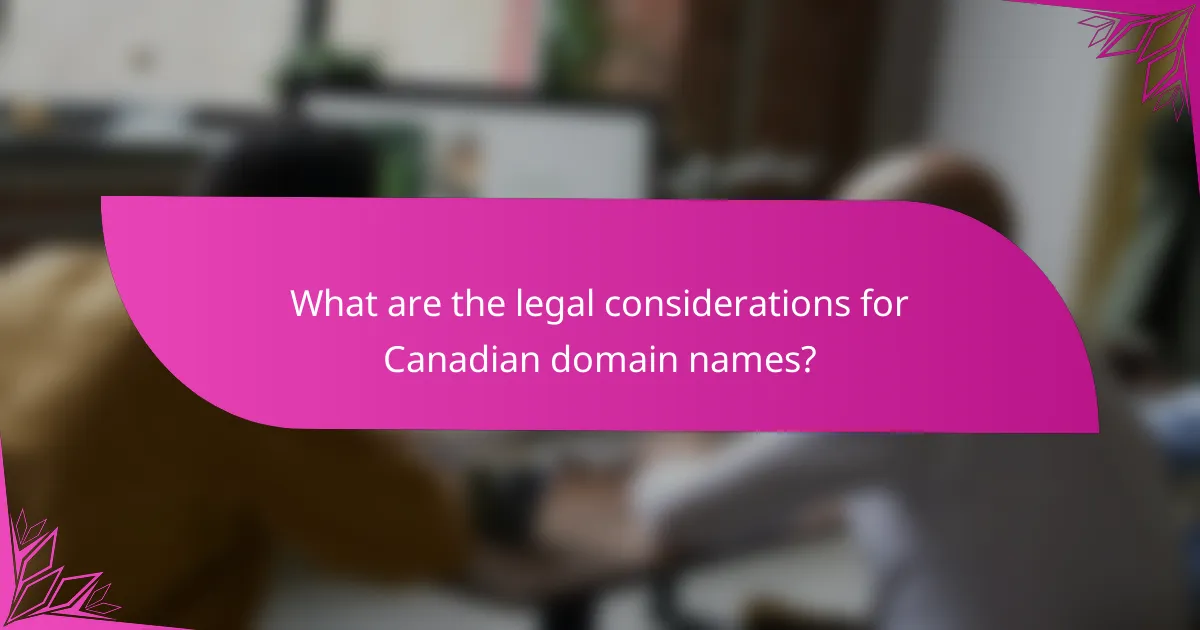Securing Canadian domain names is essential for protecting your online identity and assets. By implementing best practices, you can reduce the risks of domain theft and maintain control over your domain. Choosing a reputable registrar and understanding the potential consequences of inadequate security are crucial steps in safeguarding your online presence.

What are the best practices for securing Canadian domain names?
Securing Canadian domain names involves several key practices that help protect your online identity and assets. By following these best practices, you can minimize risks associated with domain theft and ensure your domain remains under your control.
Choose a reputable registrar
Selecting a reputable domain registrar is crucial for securing your Canadian domain name. Look for registrars that are accredited by the Canadian Internet Registration Authority (CIRA) and have a solid reputation for customer service and security measures.
Consider registrars that offer transparent pricing, reliable support, and a user-friendly interface. Reading customer reviews and checking their track record can help you make an informed choice.
Enable domain privacy protection
Domain privacy protection helps shield your personal information from public view in the WHOIS database. This service replaces your details with the registrar’s information, reducing the risk of spam and identity theft.
Many registrars offer this feature for an additional fee, which is often worth the investment for added security. Ensure you understand the terms of the privacy service, as some may have limitations on what information is protected.
Utilize two-factor authentication
Two-factor authentication (2FA) adds an extra layer of security to your domain management. By requiring a second form of verification, such as a text message or authentication app, you significantly reduce the risk of unauthorized access.
Enable 2FA on your registrar account and any associated email accounts. This step is essential, as it helps prevent domain hijacking even if your password is compromised.
Regularly update contact information
Keeping your contact information up to date is vital for domain security. Accurate details ensure that you receive important notifications regarding your domain, such as renewal reminders or security alerts.
Check your registrar account periodically to confirm that your email address and phone number are current. This practice helps you avoid losing your domain due to outdated information.
Monitor domain expiration dates
Regularly monitoring your domain’s expiration date is essential to prevent unintentional loss of ownership. Set reminders well in advance of the expiration date to ensure timely renewal.
Consider enabling auto-renewal if your registrar offers this feature. This can help you avoid lapses in ownership, but make sure your payment information is always up to date to prevent issues with the renewal process.

How to select a domain registrar in Canada?
Selecting a domain registrar in Canada involves evaluating their credibility, customer service, and pricing structure. A reliable registrar will ensure your domain is secure and easy to manage, while also providing support when needed.
Look for ICANN accreditation
Choosing a registrar that is accredited by the Internet Corporation for Assigned Names and Numbers (ICANN) is crucial for ensuring reliability. ICANN accreditation indicates that the registrar meets specific standards and is authorized to sell domain names.
To verify accreditation, you can check the ICANN website, which maintains a list of accredited registrars. This step helps you avoid potential scams or unreliable services.
Check customer reviews and support options
Researching customer reviews can provide insight into the registrar’s reputation and service quality. Look for feedback on their customer support, ease of use, and overall satisfaction from existing users.
Additionally, consider the support options available, such as live chat, email, or phone support. A registrar with responsive customer service can be invaluable, especially if you encounter issues with your domain.
Compare pricing and renewal fees
When selecting a domain registrar, it’s essential to compare initial registration costs and renewal fees. Some registrars may offer low initial prices but have significantly higher renewal rates.
Look for registrars that provide transparent pricing structures and consider any additional services included, such as WHOIS privacy protection. This can save you money in the long run and help you avoid unexpected charges.

What are the risks of not securing your domain?
Failing to secure your domain can lead to significant risks, including loss of brand identity, increased vulnerability to cyber attacks, and potential legal disputes. These issues can undermine your online presence and damage your reputation.
Potential loss of brand identity
Without proper domain security, your brand may be at risk of impersonation or phishing attacks. Cybercriminals can register similar domain names to mislead customers, leading to confusion and loss of trust. This can result in a decline in traffic and revenue.
To protect your brand identity, consider registering variations of your domain name and monitor for unauthorized registrations. Regularly check for potential infringements to maintain your brand’s integrity.
Increased vulnerability to cyber attacks
Unsecured domains are prime targets for cyber attacks, including domain hijacking and DDoS attacks. These incidents can disrupt your website, leading to downtime and loss of customer access. The financial impact can be substantial, affecting both immediate revenue and long-term customer relationships.
Implementing security measures such as two-factor authentication, strong passwords, and regular security audits can help mitigate these risks. Additionally, consider using a reputable domain registrar that offers enhanced security features.
Legal disputes over domain ownership
Failure to secure your domain can lead to legal disputes regarding ownership. If someone else registers a domain similar to yours, they may claim rights to it, complicating your ability to operate under your brand. This can result in costly legal battles and potential loss of your online presence.
To avoid these issues, ensure your domain registration is up to date and consider legal protections such as trademarks. Keeping clear documentation of your domain ownership can also be beneficial in case of disputes.

How to protect against domain hijacking?
To protect against domain hijacking, implement a combination of security measures that safeguard your domain name from unauthorized access. This includes utilizing domain locking, strong passwords, and regular account activity reviews to ensure your domain remains secure.
Implement domain locking
Domain locking is a crucial step in preventing unauthorized transfers of your domain name. When a domain is locked, it cannot be transferred to another registrar without first unlocking it, adding an extra layer of security.
Most registrars offer this feature, and it’s advisable to enable it as soon as you register your domain. Check with your registrar for specific instructions on how to lock your domain effectively.
Use strong, unique passwords
Creating strong, unique passwords for your domain registrar account is essential in preventing unauthorized access. A strong password typically includes a mix of uppercase and lowercase letters, numbers, and special characters, and should be at least 12 characters long.
Avoid using easily guessable information such as birthdays or common words. Consider using a password manager to generate and store complex passwords securely, ensuring that each account has a distinct password.
Regularly review account activity
Regularly reviewing your account activity helps identify any unauthorized changes or suspicious behavior. Most registrars provide an activity log that shows recent actions taken on your account, such as password changes or transfer requests.
Set a reminder to check this log monthly. If you notice any unfamiliar activity, take immediate action by changing your password and contacting your registrar for assistance. This proactive approach can help mitigate potential threats to your domain security.

What are the legal considerations for Canadian domain names?
When securing Canadian domain names, it’s essential to understand the legal framework that governs their registration and use. This includes compliance with various laws and regulations that can impact your rights and responsibilities as a domain owner.
Understand Canadian Anti-Spam Legislation
The Canadian Anti-Spam Legislation (CASL) sets strict rules regarding electronic communications. If you plan to use your domain for email marketing, ensure that you obtain consent from recipients before sending commercial messages.
Non-compliance with CASL can lead to significant penalties, including fines that can reach into the millions of Canadian dollars. Familiarize yourself with the requirements for obtaining consent, providing identification, and offering an unsubscribe mechanism in your communications.
Comply with trademark laws
Trademark laws in Canada protect brands and prevent domain name disputes. Before registering a domain, conduct a trademark search to ensure that your chosen name does not infringe on existing trademarks.
If a domain name is similar to a registered trademark, you may face legal challenges or be forced to relinquish the domain. It’s advisable to consult with a legal expert to navigate potential trademark issues effectively.
Be aware of the Canadian Internet Registration Authority policies
The Canadian Internet Registration Authority (CIRA) manages the .ca domain and has specific policies that registrants must follow. Familiarize yourself with CIRA’s rules regarding eligibility, registration, and domain management to avoid issues.
For instance, CIRA requires that .ca domain registrants be Canadian citizens, permanent residents, or entities registered in Canada. Ensure that you meet these criteria before proceeding with your registration to maintain compliance.

How to handle domain disputes in Canada?
To handle domain disputes in Canada, it is essential to understand the process and legal frameworks involved. The Canadian Internet Registration Authority (CIRA) provides a clear dispute resolution policy that outlines steps for resolving conflicts over domain names.
Understanding CIRA’s Dispute Resolution Policy
CIRA’s Dispute Resolution Policy (DRP) is designed to resolve conflicts regarding .ca domain names. It allows parties to file complaints if they believe a domain name is registered in bad faith or infringes on their rights. The process typically involves mediation, arbitration, or a formal hearing.
Filing a complaint under the DRP requires the complainant to demonstrate that they have rights to the name and that the domain registration is abusive. This can include trademark rights or prior use of a similar name.
Steps to Resolve a Domain Dispute
To resolve a domain dispute in Canada, follow these steps: first, gather evidence of your rights to the domain name. Next, file a complaint with CIRA, providing all necessary documentation. After that, be prepared for mediation or arbitration, where both parties can present their cases.
It is advisable to seek legal counsel familiar with Canadian domain law to navigate the complexities of the dispute process effectively. This can help ensure that your rights are adequately represented and that you follow the correct procedures.
Common Pitfalls to Avoid
One common pitfall is failing to document your rights to the domain name adequately. Without clear evidence, your case may be weak. Additionally, some individuals mistakenly believe that simply owning a trademark guarantees them the domain name, but the DRP requires a more comprehensive demonstration of rights.
Another issue is not adhering to the time limits for filing complaints. Ensure you are aware of all deadlines to avoid losing your chance to contest a domain registration.
